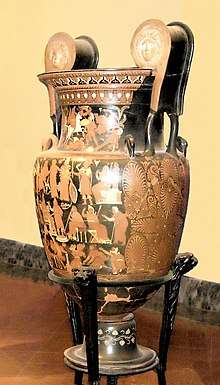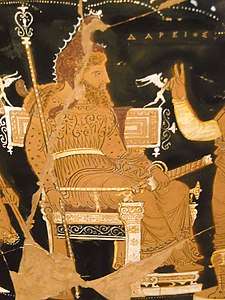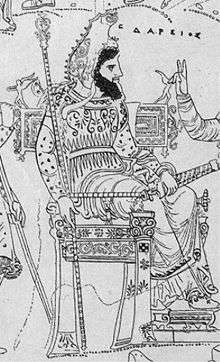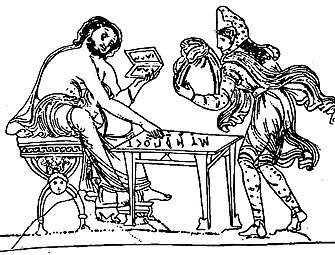Darius Vase
The Darius Vase is a famous vase painted by an anonymous Magna Graecia Apulian vase painter, commonly called the Darius Painter, the most eminent representative at the end of the "Ornate Style" in South Italian red-figure vase painting. The vase was produced between 340 and 320 BCE, probably in a large factory-like workshop in the Greek city of Taranto (ancient Taras), Magna Graecia, well before the fall of Taranto to the Romans in 272 BCE. It is an important part of Apulian vase painting.

The "Darius Vase" was discovered in 1851 near Canosa di Puglia and is now on display at the Museo Archaeologico Nazionale, Naples (H3253). This work, a volute krater is of large dimensions. It is 1.3 meters in height and 1.93 meters in circumference.[1]
The vase contains several inscriptions, such as naming individual figures, but there are also thematical names (such as persai - Persians). To some extent these inscriptions can be seen as "titles". All available space on the vase is used for figural depictions, arranged in two or three registers. Some individual zones are structured by opulent ornamental friezes. The Darius Painter is considered the first painter to have fully exploited the possibilities of large-format vase painting. His drawing style is reputed to be especially good, particular as regards faces, which he often depicts in a three-quarter profile.
Content of the vase
Neck of the vase: Combat scenes

The neck of the vase shows combat scenes between the Greeks and the Persians. It is generally thought that these scenes represents the combats between Alexander the Great and Darius III, rather than the earlier combats of the troops of Darius I during his First Persian invasion of Greece.[1]
Top tier: Greek gods
.jpg)
Above Darius stands a line of Greek Gods: Artemis riding a stag, Apollo seated holding a swan, Aphrodite together with Eros, Zeus holding a winged thunderbolt, Hellas standing, Athena holding a shield, Apate holding two torches, Asia seated on an altar, next to a pillar holding a head (possibly of xoanon).[1]
Middle tier: Darius and his court
Darius I is shown seated, wearing a long, ornate, sleeved robe and a high Persian hat. A body guard stands behind him, as Darius is listening to an allegory of the Persian people, enjoining him not to attack the Greeks.[2][3] Darius could also be simply listening to a messenger.[4] Xerxes I, still a Prince, is said to be represented, second from right. The scene of the audience given by an Achaemenid ruler seems to have been quite conventional, and also appears in a similar fashion in the frieze on the tomb of Lycian ruler Arbinas.[4]
Bottom tier: tax collection

A tax collector, the Royal Treasurer, is seen receiving payments by various conquered nations, whose representatives crouch before him.[5] On a table lays a calculating table (a reckoning board or abax, used for complicated calcutations), with a number of small pebbles or counters in front of the Greek numerals for calculating large numbers.[6][5][2] The symbol "O" appears in the calculation table, a Boetian symbol for the obol, or small unit.[5] The use of pebbles on a board to make calculations is illustrated down to modern times by the fact that calx is "pebble" in Latin, which is the etymological root for the word "calculation".[2]
The board contains the letters M (= 10.000), Ψ (Boetian for 1.000), H (= 100), Δ (= 10) and ![]()
Influences
The Darius vase may have represented a scene from a Greek drama.[3] The depiction of Darius on his name-vase is possibly derived in its details from the Persae of Phrynikos, C. Anti concluded in 1952, and Schmidt 1960 follows him. However Oliver Taplin notes in Pots and Plays, 2007, p. 235-7, the only strong indications of tragic reference are Darius himself and the old man in paidagogos outfit on the plinth inscribed ΠΕΡΣΑΙ, who might be performing the messenger role. Taplin speculates that the iconography of tragedy "could be assimilated into other contexts without danger of confusion", op. cit. p. 237.
Gallery
 Depiction of Darius the Great and its inscription (ΔΑΡΕΙΟΣ, top right) on the "Darius Vase"
Depiction of Darius the Great and its inscription (ΔΑΡΕΙΟΣ, top right) on the "Darius Vase" Drawing of Darius on the vase.
Drawing of Darius on the vase. Darius receiving advice from the Persians.
Darius receiving advice from the Persians. Abax depicted on the Darius vase[10]
Abax depicted on the Darius vase[10] The Tax collecter scene.
The Tax collecter scene. Battle between Greeks and Persians, on the reverse of the Darius Vase.
Battle between Greeks and Persians, on the reverse of the Darius Vase.
See also
References
- Long, Charlotte R. (1987). The Twelve Gods of Greece and Rome. Brill Archive. p. 350. ISBN 9004077162.
- Menninger, Karl (2013). Number Words and Number Symbols: A Cultural History of Numbers. Courier Corporation. p. 315. ISBN 9780486319773.
- Harrison, Thomas (2009). The Great Empires of the Ancient World. Getty Publications. p. 109. ISBN 9780892369874.
- Marincola, John (2012). Greek Notions of the Past in the Archaic and Classical Eras. Edinburgh University Press. p. 240. ISBN 9780748654666.
- "the Royal Treasurer is seen calculating the value of the tributes paid in by the conquered nations, whose representatives crouch before him." in Kaplan, Robert (1999). The Nothing that Is: A Natural History of Zero. Oxford University Press. pp. 37–38. ISBN 9780199880898.
- Gow, James (2010). A Short History of Greek Mathematics. Cambridge University Press. p. 34. ISBN 9781108009034.
- Smith, David E. (1958). History of Mathematics. Courier Corporation. p. 161. ISBN 9780486204307.
- McLean, Bradley Hudson (2002). An Introduction to Greek Epigraphy of the Hellenistic and Roman Periods from Alexander the Great Down to the Reign of Constantine (323 B.C.-A.D. 337). University of Michigan Press. p. 61. ISBN 0472112384.
- Schärlig, Alain (2001). Compter avec des cailloux: le calcul élémentaire sur l'abaque chez les anciens Grecs. PPUR presses polytechniques. p. 97. ISBN 9782880744533.
- Williams, Michael R. (1998). A history of computing technology (2nd ed., 2nd print. ed.). Los Alamitos, Calif.: IEEE Computer Soc. p. 56. ISBN 978-0-8186-7739-7.
Sources
- Margot Schmidt. Der Dareiosmaler und sein Umkreis: Untersuchen zur Spätapulischen Vasenmalerei, Munich: Aschendorff, 1960.
- Jean-Marc Moret. L'Ilioupersis dans la céramique italiote, les mythes et leur expression figurée au IVe siècle, Institut Suisse de Rome, 1975.
- Thomas Morard, Horizontalité et verticalité. Le bandeau humain et le bandeau divin chez le Peintre de Darius, Mainz, von Zabern, 2009.
- Alexandre Cambitoglou, Arthur Dale Trendall. The Red-figured Vases of Apulia, II, Late Apulian, Oxford, 1982: p. 482-522. Bibliography.
- Christian Aellen, Alexandre Cambitoglou, Jacques Chamay. Le peintre de Darius et son milieu, Vases grecs d'Italie Méridionale, Hellas et Roma, Genf 1986.
- Arthur Dale Trendall. Rotfigurige Vasen aus Unteritalien und Sizilien. Ein Handbuch. von Zabern, Mainz 1991 (Kulturgeschichte der Antiken Welt Vol. 47), ISBN 3-8053-1111-7 (p. 85-177).
- Françoise-Hélène Massa-Pairault. Le Peintre de Darius et l'actualité. De la Macédoine à la Grande Grèce, in L'incidenza dell'Antico II: studi in memore di Ettore Lepore, Napoli, 1996.
- Rolf Hurschmann. Dareios-Maler, in Der Neue Pauly Vol. 3 (1997), col. 324.
- Claude Pouzadoux, Guerre et paix en Peucétie à l'époque d'Alexandre le Molosse (notes sur quelques vases du Peintre de Darius), in Le Canal d'Otrante et la Méditerranée antique et médiévale, colloque organisée à l'Université de Paris X - Nanterre (20-21 novembre 2000), Edipuglia, Bari, 2005.
| Wikimedia Commons has media related to Darius Vase. |